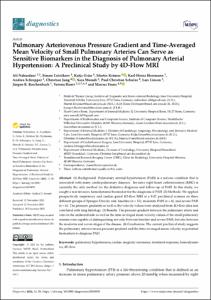Nahardani, Ali; Leistikow, Simon; Grün, Katja; Krämer, Martin; Herrmann, Karl-Heinz; Schrepper, Andrea; Jung, Christian; Moradi, Sara; Schulze, Paul Christian; Linsen, Lars; Reichenbach, Jürgen R.; Hoerr, Verena; Franz, Marcus: Pulmonary Arteriovenous Pressure Gradient and Time-Averaged Mean Velocity of Small Pulmonary Arteries Can Serve as Sensitive Biomarkers in the Diagnosis of Pulmonary Arterial Hypertension : A Preclinical Study by 4D-Flow MRI. In: Diagnostics. 2022, vol. 12, iss. 58, 1-13.
Online-Ausgabe in bonndoc: https://hdl.handle.net/20.500.11811/10621
Online-Ausgabe in bonndoc: https://hdl.handle.net/20.500.11811/10621
@article{handle:20.500.11811/10621,
author = {{Ali Nahardani} and {Simon Leistikow} and {Katja Grün} and {Martin Krämer} and {Karl-Heinz Herrmann} and {Andrea Schrepper} and {Christian Jung} and {Sara Moradi} and {Paul Christian Schulze} and {Lars Linsen} and {Jürgen R. Reichenbach} and {Verena Hoerr} and {Marcus Franz}},
title = {Pulmonary Arteriovenous Pressure Gradient and Time-Averaged Mean Velocity of Small Pulmonary Arteries Can Serve as Sensitive Biomarkers in the Diagnosis of Pulmonary Arterial Hypertension : A Preclinical Study by 4D-Flow MRI},
publisher = {MDPI},
year = 2021,
month = dec,
journal = {Diagnostics},
volume = 2022, vol. 12,
number = iss. 58,
pages = 1--13,
note = {(1) Background: Pulmonary arterial hypertension (PAH) is a serious condition that is associated with many cardiopulmonary diseases. Invasive right heart catheterization (RHC) is currently the only method for the definitive diagnosis and follow-up of PAH. In this study, we sought a non-invasive hemodynamic biomarker for the diagnosis of PAH. (2) Methods: We applied prospectively respiratory and cardiac gated 4D-flow MRI at a 9.4T preclinical scanner on three different groups of Sprague Dawley rats: baseline (n = 11), moderate PAH (n = 8), and severe PAH (n = 8). The pressure gradients as well as the velocity values were analyzed from 4D-flow data and correlated with lung histology. (3) Results: The pressure gradient between the pulmonary artery and vein on the unilateral side as well as the time-averaged mean velocity values of the small pulmonary arteries were capable of distinguishing not only between baseline and severe PAH, but also between the moderate and severe stages of the disease. (4) Conclusions: The current preclinical study suggests the pulmonary arteriovenous pressure gradient and the time-averaged mean velocity as potential biomarkers to diagnose PAH.},
url = {https://hdl.handle.net/20.500.11811/10621}
}
author = {{Ali Nahardani} and {Simon Leistikow} and {Katja Grün} and {Martin Krämer} and {Karl-Heinz Herrmann} and {Andrea Schrepper} and {Christian Jung} and {Sara Moradi} and {Paul Christian Schulze} and {Lars Linsen} and {Jürgen R. Reichenbach} and {Verena Hoerr} and {Marcus Franz}},
title = {Pulmonary Arteriovenous Pressure Gradient and Time-Averaged Mean Velocity of Small Pulmonary Arteries Can Serve as Sensitive Biomarkers in the Diagnosis of Pulmonary Arterial Hypertension : A Preclinical Study by 4D-Flow MRI},
publisher = {MDPI},
year = 2021,
month = dec,
journal = {Diagnostics},
volume = 2022, vol. 12,
number = iss. 58,
pages = 1--13,
note = {(1) Background: Pulmonary arterial hypertension (PAH) is a serious condition that is associated with many cardiopulmonary diseases. Invasive right heart catheterization (RHC) is currently the only method for the definitive diagnosis and follow-up of PAH. In this study, we sought a non-invasive hemodynamic biomarker for the diagnosis of PAH. (2) Methods: We applied prospectively respiratory and cardiac gated 4D-flow MRI at a 9.4T preclinical scanner on three different groups of Sprague Dawley rats: baseline (n = 11), moderate PAH (n = 8), and severe PAH (n = 8). The pressure gradients as well as the velocity values were analyzed from 4D-flow data and correlated with lung histology. (3) Results: The pressure gradient between the pulmonary artery and vein on the unilateral side as well as the time-averaged mean velocity values of the small pulmonary arteries were capable of distinguishing not only between baseline and severe PAH, but also between the moderate and severe stages of the disease. (4) Conclusions: The current preclinical study suggests the pulmonary arteriovenous pressure gradient and the time-averaged mean velocity as potential biomarkers to diagnose PAH.},
url = {https://hdl.handle.net/20.500.11811/10621}
}






